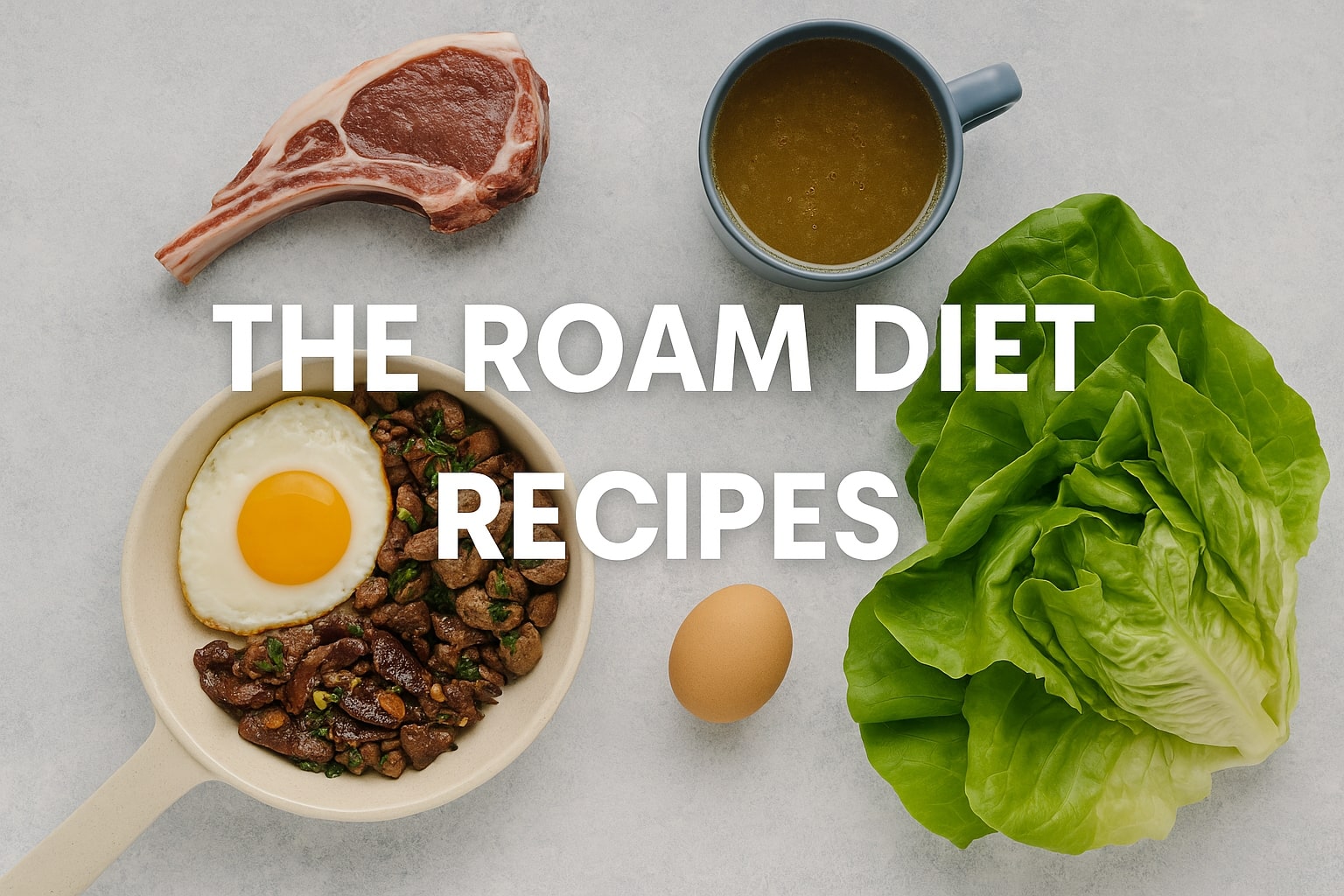Roam diet recipes changed the way I eat — and honestly, I’m never going back.
Ever stood in your kitchen wondering what to cook that’s healthy but doesn’t suck?
Been there.
That’s why I started cooking with simple, clean ingredients — real meat, real fat, no guesswork.
Just food that tastes good and actually does something for your body.
In this guide, I’ll share my favorite Roam meals, small cooking hacks I use all the time, and quick tips that make everything easier (and tastier).
No fancy chef skills needed.
So grab a pan and some grass-fed meat — let’s keep it real, keep it clean, and definitely keep it delicious.
What is the Roam Diet and Why Is It Different?
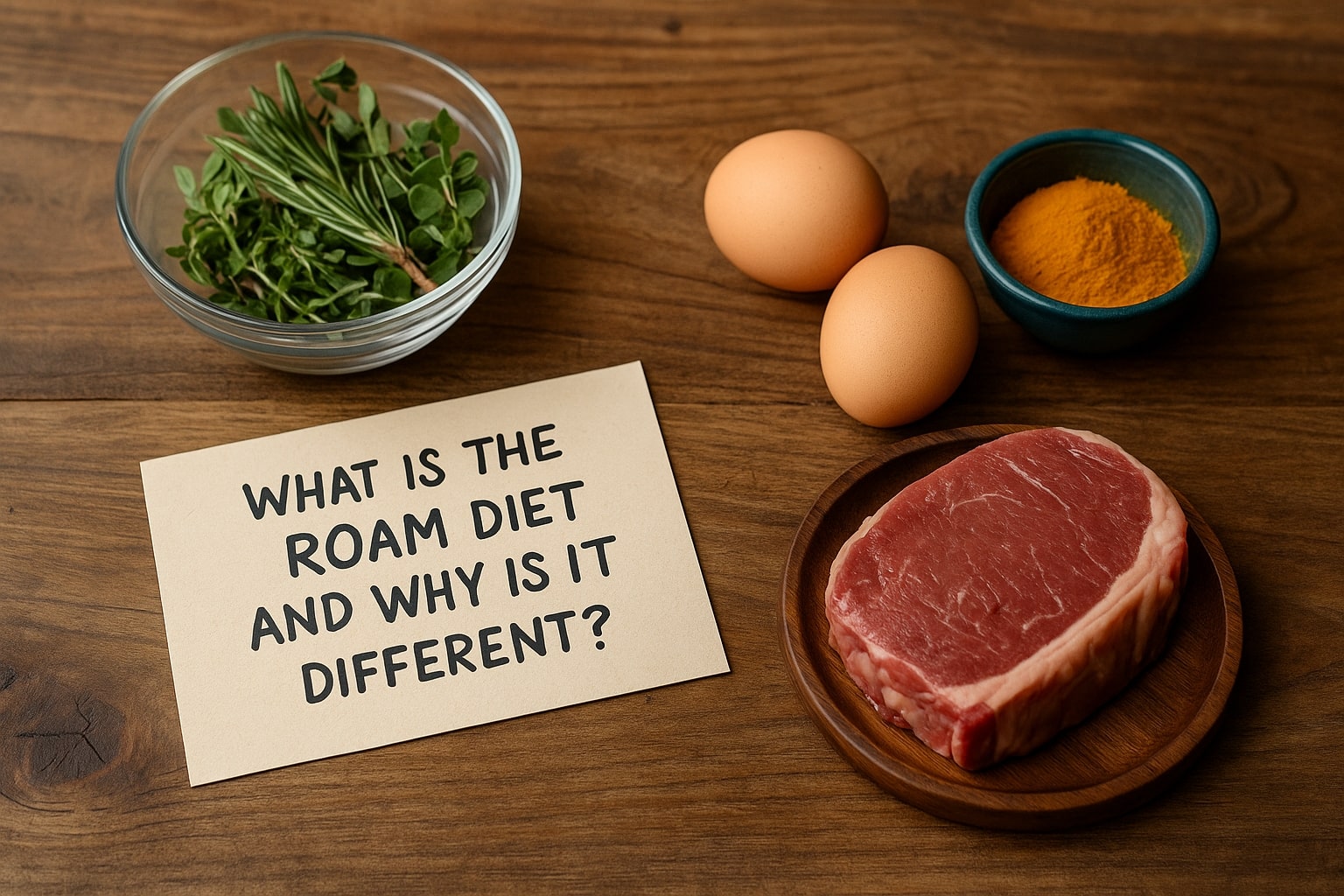
Let’s clear one thing first — roam diet recipes aren’t about following strict rules or starving yourself.
They’re about eating the way nature intended: clean, nutrient-rich meals made from grass-fed meats, healthy fats, and ingredients your great-grandparents would recognize.
I started the Roam diet when I got tired of confusing labels and feeling sluggish after every “healthy” meal.
This way of eating brought me back to basics — and trust me, my energy, focus, and digestion all thanked me for it.
So what makes the Roam Diet different?
-
It’s meat-forward, not meat-only
-
It focuses on pasture-raised, hormone-free proteins
-
You eat whole foods — nothing processed or fake
-
It’s more flexible than keto, and way simpler than paleo
For me, it’s not a trend. It’s how I cook now — every single day.
Below, I’m sharing the exact roam diet recipes I cook in my own kitchen.
They’re easy, full of flavor, and made for real life — no chef hat required.
Let’s get to it.
Roam vs Paleo, Carnivore, and Keto: Key Differences
If you’ve been searching for roam diet recipes, chances are you’ve already run into Paleo, Keto, or even Carnivore diets along the way.
And let’s be honest — they all sound kind of similar at first.
But after trying them myself, I realized they’re built on very different rules.
Paleo cuts out grains and legumes. Keto focuses on fats and keeps your carbs super low.
Carnivore? That one skips everything except meat.
The Roam Diet takes a different route.
It’s not about removing food groups or chasing macros.
It’s about choosing better quality food — clean, ethically raised, and minimally processed.
You still enjoy meat, fats, and even some flexibility, but without the pressure of strict rules or complicated meal math.
This is exactly why I stuck with Roam. I could enjoy my favorite protein-packed meals and still feel energized, satisfied, and consistent — no burnout, no boredom.
And trust me, once you start using roam diet recipes that focus on flavor and function, you won’t want to go back.
I’ve broken down the key differences in a quick table below — take a look before you start planning your next meal.
| Diet | What You Eat | What Makes It Hard | How Roam Is Different |
|---|---|---|---|
| Keto | High fat, very low carb | Strict tracking, low carb tolerance | Roam doesn’t track macros, just clean ingredients |
| Paleo | Whole foods, no grains or legumes | Can feel overly restrictive | Roam is simpler, focused on meat quality |
| Carnivore | Only animal-based foods | Lacks balance, no fiber or plants | Roam allows variety, supports gut health |
Clean Protein & Grass-Fed: What Roam Really Means
Let’s be real — not all meat is created equal.
You can eat a steak from the store and still feel bloated, heavy, or just… off.
That’s because it’s not about the meat, it’s about the quality.
Roam diet recipes are built on one core rule: only clean, responsibly raised meat goes on your plate.
Here’s what that looks like:
-
Grass-fed and grass-finished beef
-
Pasture-raised lamb and chicken
-
No hormones, no antibiotics, no grain-fed shortcuts
-
Animals raised in natural environments, not feedlots
And believe me — you can taste the difference.
The first time I made a roast with real roam-approved lamb, it blew me away.
The texture, the flavor, the way I felt after eating — it was next level.
That’s the heart of the Roam diet: clean protein that fuels, not drains.
So as we jump into the recipes below, know this — every dish is built around real, powerful ingredients that your body actually understands.
Not just food. Real nourishment.
Benefits of Eating the Roam Way
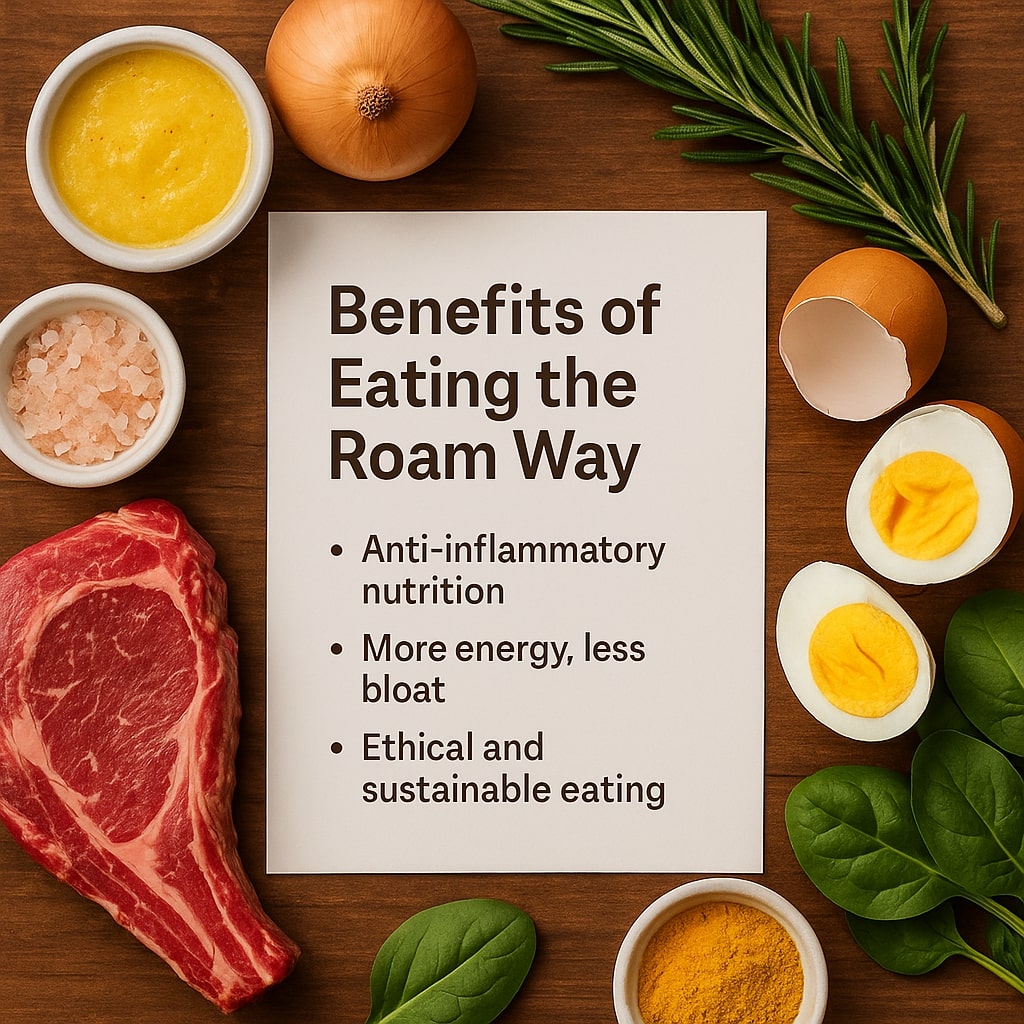
When I first started following roam diet recipes, I wasn’t expecting anything dramatic.
I just wanted to eat cleaner — fewer chemicals, fewer regrets.
But the results? Way better than I imagined.
I felt lighter, clearer, and honestly more in control of my meals.
The kind of energy I got from pasture-raised meats and simple whole foods made me realize: eating well doesn’t have to feel like punishment.
And the flavor? Let’s just say — I didn’t miss takeout one bit.
Below are a few of the biggest wins I’ve seen (and felt) since switching to the Roam way of eating.
Anti-inflammatory Nutrition
-
Fewer processed oils
-
No hidden sugars
-
Less digestive stress
This kind of food is gentle on your body — and it shows.
If you’ve ever felt “heavy” after eating, these recipes will flip that experience.
More Energy, Less Bloat
-
No carb crashes
-
Steady energy through the day
-
Light, satisfying meals
I used to hit a wall every afternoon. Since going Roam, I don’t even need coffee after lunch. True story.
Ethical and Sustainable Eating
-
You support local, ethical farms
-
Fewer chemicals go into the soil and water
-
Animals are treated with respect
And hey — if you enjoy meals that feel meaningful too, you’ll love this one:
Try something like these fusion-style, real meat recipes — they pack flavor and purpose.
Pantry Staples and Kitchen Tools You’ll Need
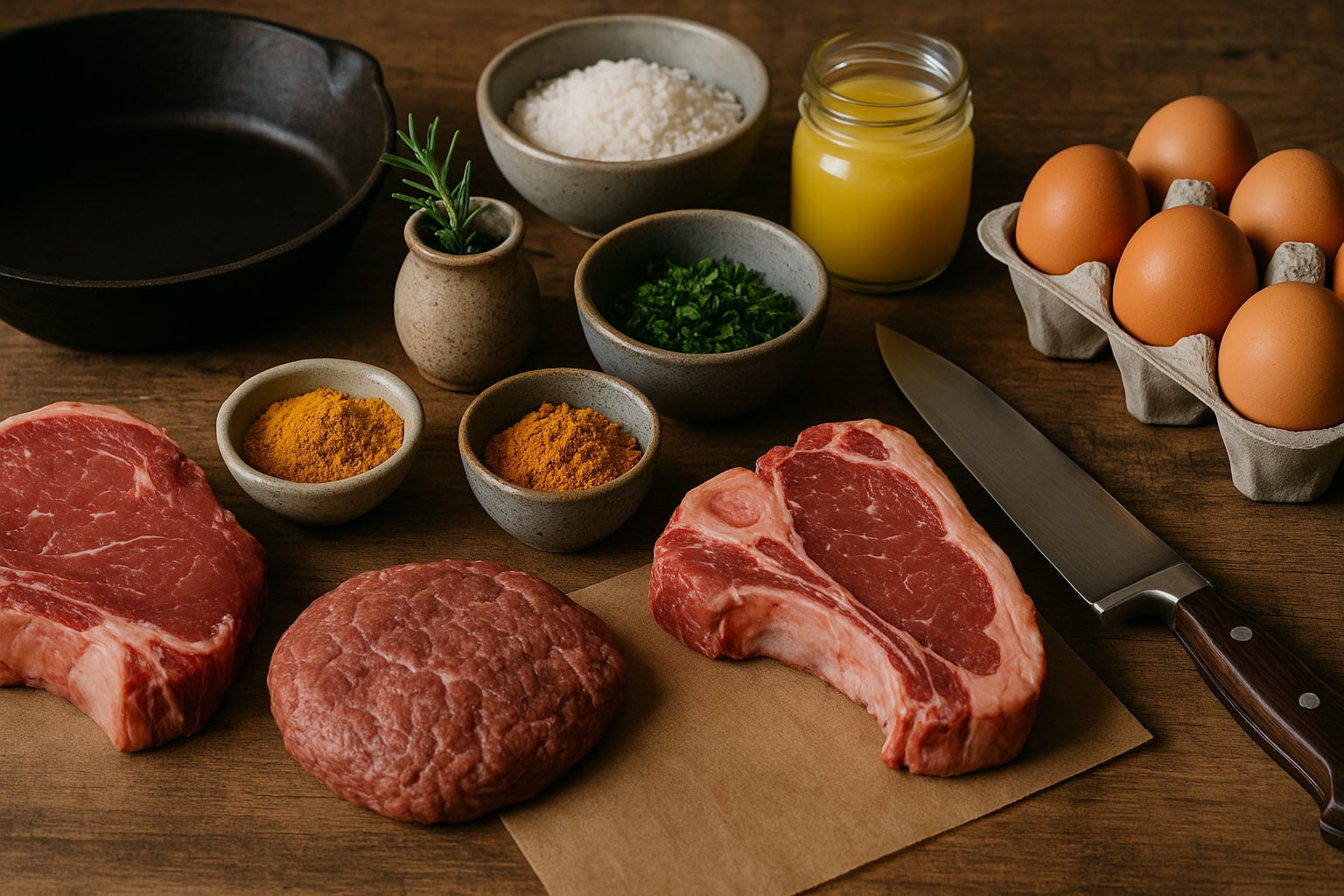
Before you start cooking up your favorite roam diet recipes, let’s set up your kitchen the right way.
You don’t need anything fancy.
But a few smart ingredients and tools can make the whole process smoother — and tastier.
These are the exact staples I keep stocked for roam-friendly cooking, plus the tools I reach for daily when prepping clean, high-protein meals.
Essential Roam Ingredients
These are your go-to staples for building solid roam diet recipes — clean, real, and nutrient-dense.
-
Grass-fed beef & lamb (frozen or fresh)
-
Pasture-raised chicken & bone broth
-
Ghee, tallow, and duck fat (ditch seed oils)
-
Sea salt, turmeric, garlic powder
-
Fresh herbs like rosemary, thyme, oregano
-
Free-range eggs — I always keep a dozen on hand
I usually bulk-buy meat online from trusted farms — saves time and keeps me stocked for the week.
Meat Prep Tools I Personally Recommend
These are the exact tools I use every week — nothing fancy, just practical.
-
Sharp chef’s knife (meat prep becomes 10x easier)
-
Cast iron skillet (perfect sears + flavor)
-
Instant Pot or Slow Cooker (especially for stews and bone broth)
-
Glass containers for storage (safer than plastic)
-
Digital thermometer (no more guessing if it’s cooked right)
Pro tip: I batch-cook all my meats on Sunday using just a skillet and my Instant Pot. That’s my whole meal prep plan right there.
Optional Add-ons for Flavor Boosts
Want to level up the taste? These extras help without breaking the Roam rules.
-
Coconut aminos (soy sauce replacement)
-
Apple cider vinegar (for marinades)
-
Fresh garlic, lemon zest, crushed chili flakes
-
Bone marrow or liver bits (for nutrient boost)
-
Roam-safe seasoning blends (just check labels!)
Sometimes I toss in rosemary and crushed chili when pan-searing lamb — that flavor hit is unmatched.
| Roam-Approved Ingredients ✅ | Not Roam-Approved ❌ |
|---|---|
| Grass-fed beef & lamb | Grain-fed or factory-farmed meat |
| Pasture-raised chicken | Caged, antibiotic-injected poultry |
| Ghee, tallow, duck fat | Canola oil, soybean oil, margarine |
| Sea salt, turmeric, garlic | MSG, artificial flavors, refined salt |
| Free-range eggs | Battery-cage or processed egg products |
I recommend printing this table or saving it to your phone — it’ll make grocery runs 10x easier when you’re stocking up for your next roam diet recipes.
Easy Roam Diet Recipes (With Ingredients & Cooking Steps)
Alright, now that your pantry’s stocked and your tools are ready — let’s get to the fun part: cooking.
These roam diet recipes are simple, clean, and full of flavor.
You won’t find any weird ingredients or fancy steps here. Just real food, done right.
Each recipe below is something I actually cook in my own kitchen. I’ve kept them short, clear, and beginner-friendly — whether you’re cooking for yourself or feeding the family.
Plus, I’ve added little tips and personal tricks I’ve picked up along the way — the kind of stuff that makes a big difference but never gets mentioned in regular recipes.
Let’s start with the most underrated combo ever: liver and eggs.
Breakfast – Liver & Egg Power Hash
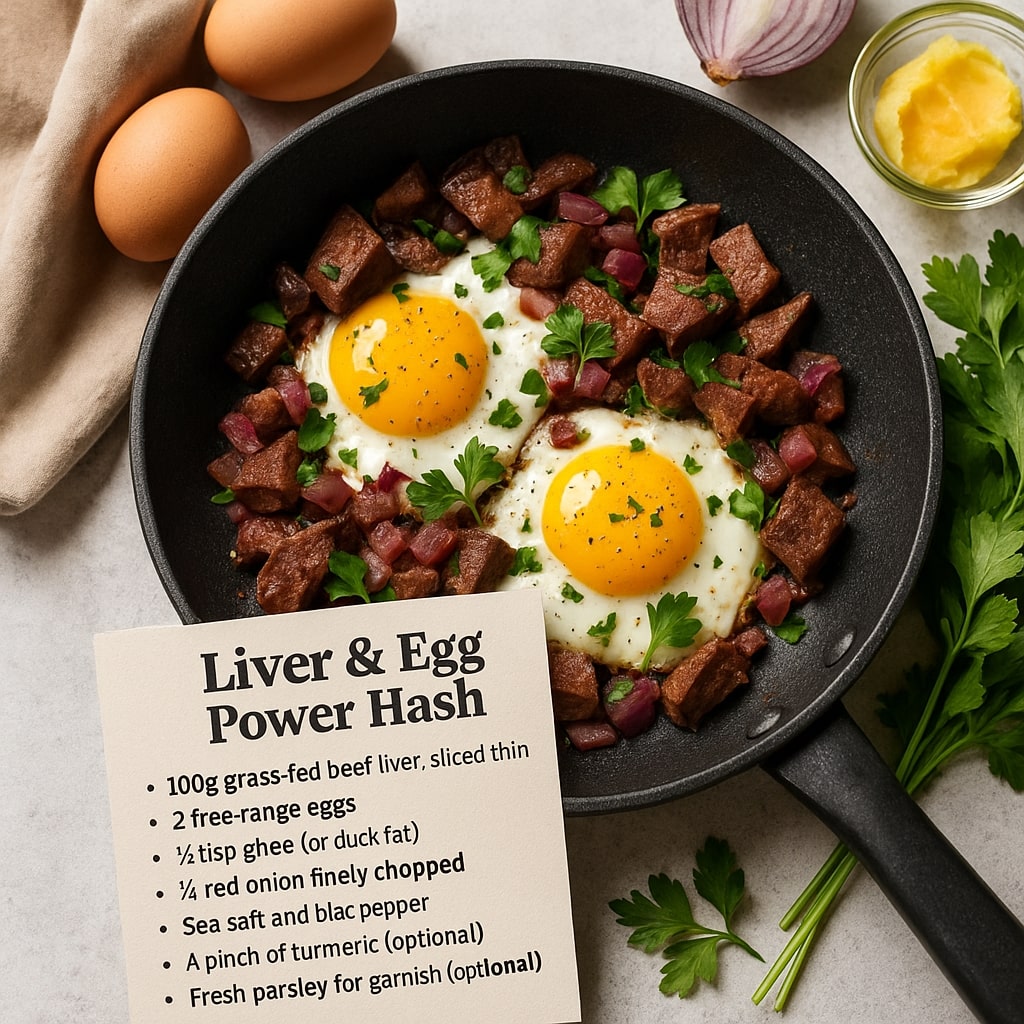
If you’ve never cooked liver before, don’t worry — this one’s beginner-friendly and surprisingly tasty.
It’s loaded with clean protein, iron, and healthy fats. Perfect way to start your Roam day.
Ingredients:
-
100g grass-fed beef liver, sliced thin
-
2 free-range eggs
-
1 tbsp ghee (or duck fat)
-
¼ red onion, finely chopped
-
Sea salt and black pepper
-
A pinch of turmeric (optional)
-
Fresh parsley for garnish (optional)
Step-by-Step Instructions:
-
Heat the ghee in a skillet on medium heat.
-
Add chopped onion, sauté until soft and golden.
-
Add liver slices — cook each side for 2–3 minutes max. Don’t overcook.
-
Push liver to the side and crack eggs directly into the pan.
-
Cover and cook until yolks are just set (or however you like your eggs).
-
Sprinkle sea salt, pepper, and turmeric.
-
Plate it up and top with fresh parsley if you’re feeling fancy.
Pro tip: I usually prep this for Sunday brunch. It takes 10 minutes, and I feel full for hours. Plus, liver cooks fast — so it’s perfect if you’re in a rush.
Lunch – Roam Beef Lettuce Wraps
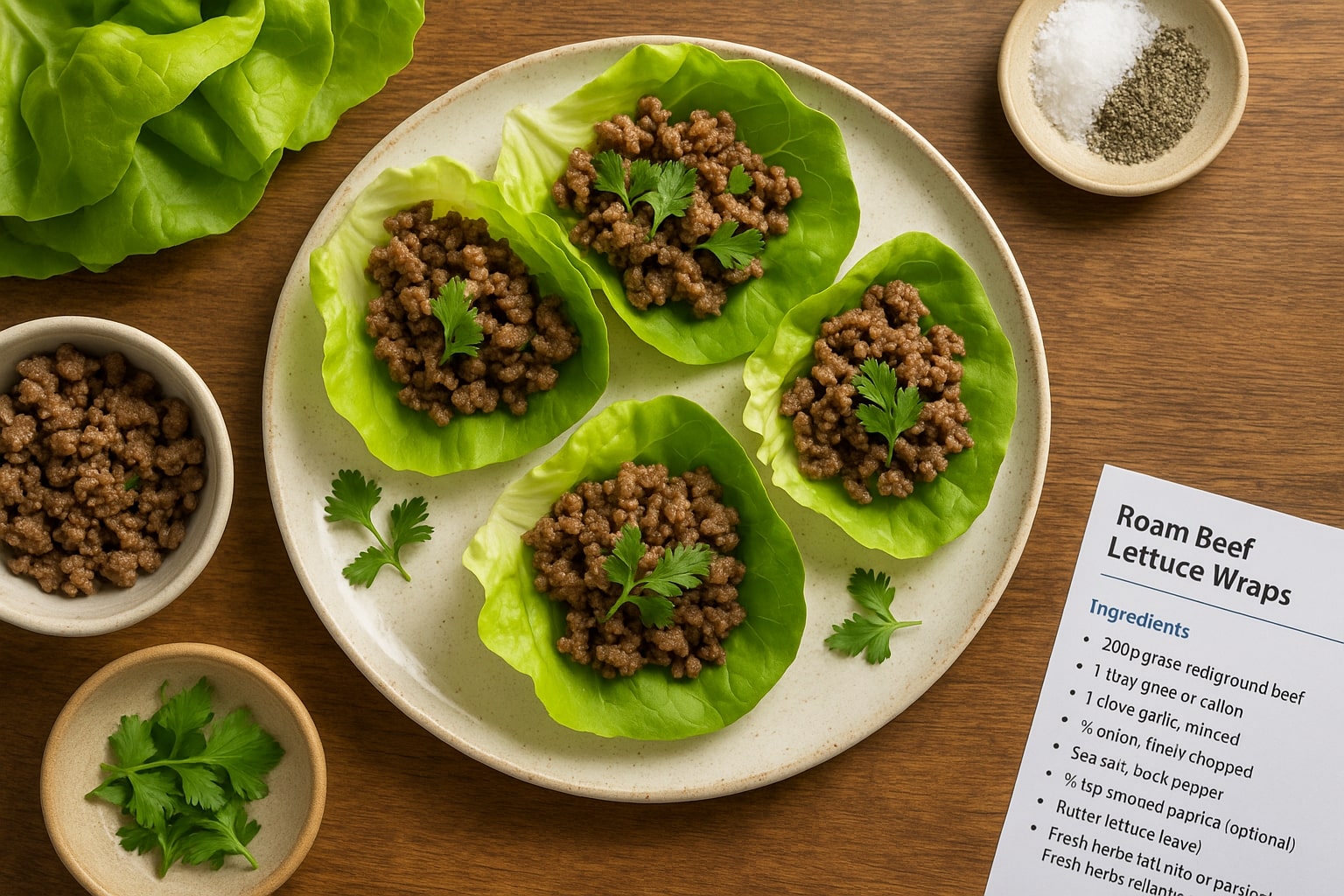
Quick to make, easy to eat, and surprisingly filling — these lettuce wraps are one of my go-to roam diet recipes for lunch.
They’re packed with grass-fed beef and wrapped in crisp butter lettuce for that perfect balance of flavor and crunch.
Ingredients:
-
200g grass-fed ground beef
-
1 tbsp ghee or tallow
-
1 clove garlic, minced
-
¼ onion, finely chopped
-
Sea salt, black pepper
-
½ tsp smoked paprika (optional)
-
Butter lettuce leaves (washed and dry)
-
Fresh herbs (cilantro or parsley)
Step-by-Step Instructions:
-
Heat ghee in a pan over medium heat.
-
Add garlic and onion — cook until soft and fragrant.
-
Add ground beef and cook until browned, breaking it up with a spoon.
-
Season with salt, pepper, and paprika.
-
Spoon the beef mixture into lettuce cups.
-
Top with fresh herbs and gently roll each lettuce leaf into a wrap
Pro Tip:
Use butter lettuce — it’s soft, holds the meat better, and has a mild flavor that doesn’t overpower the filling. I keep a head of it in the fridge just for these wraps.
Dinner – Garlic Herb Lamb Chops
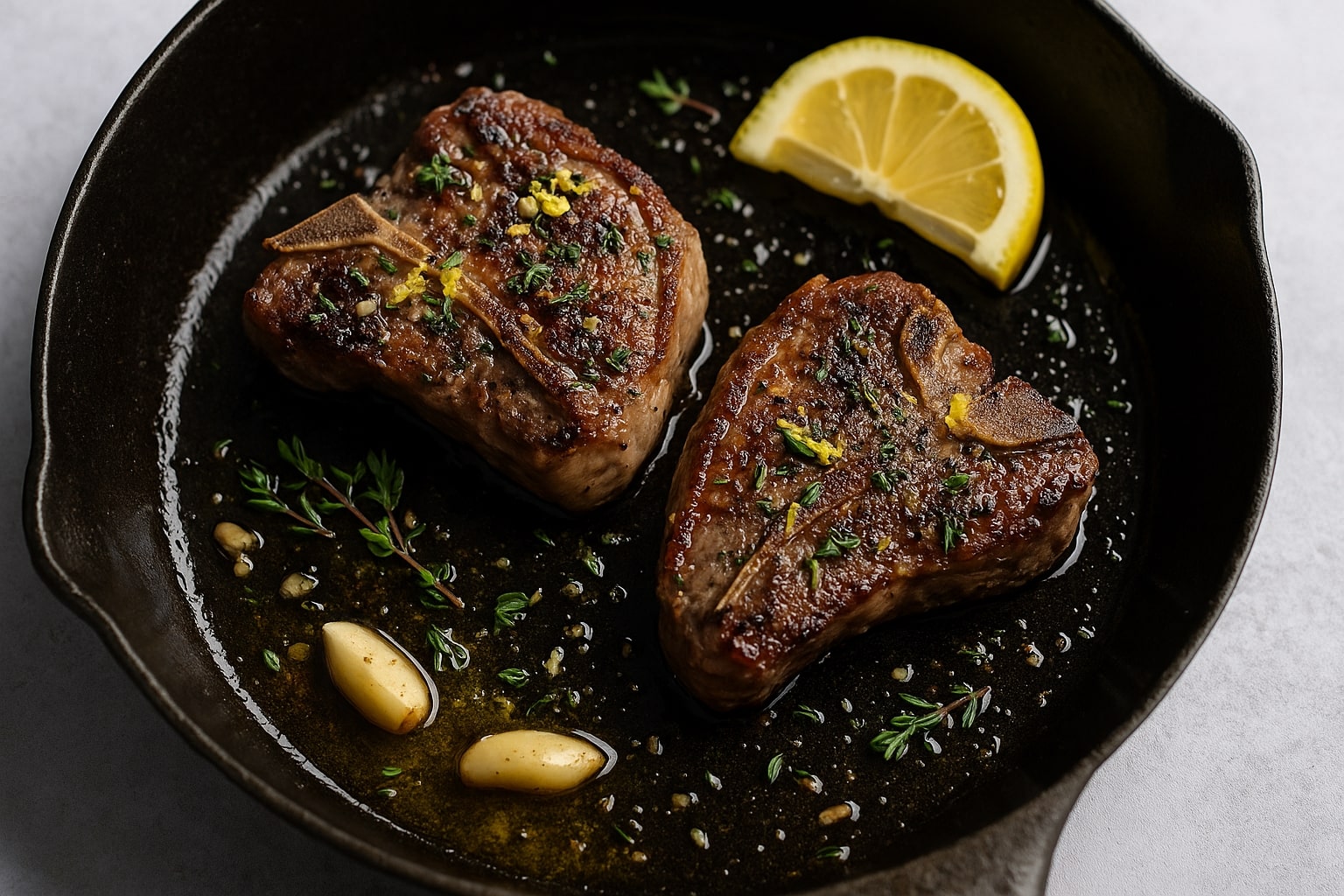
If you want a dinner that feels fancy but cooks fast — this is it.
These garlic herb lamb chops are rich, juicy, and loaded with flavor. Perfect for when you want to impress without spending hours in the kitchen.
Ingredients:
-
2 pasture-raised lamb chops
-
1 tbsp ghee or olive oil
-
2 garlic cloves, minced
-
1 tsp fresh rosemary (or ½ tsp dried)
-
1 tsp fresh thyme
-
Sea salt and black pepper
-
Optional: lemon zest for extra brightness
Step-by-Step Instructions:
-
Pat the lamb chops dry and season both sides with salt, pepper, and herbs.
-
Heat ghee in a cast iron skillet over medium-high heat.
-
Add lamb chops and sear for 3–4 minutes per side, depending on thickness.
-
In the last minute, add garlic to the pan and spoon the oil over the chops.
-
Remove from heat, rest for 5 minutes, then serve with lemon zest on top (optional).
Pro Tip:
I recommend using a cast iron pan — you’ll get that perfect crust on the outside and a juicy center inside. Game changer for meat lovers.
Snack – Bone Broth Power Cups
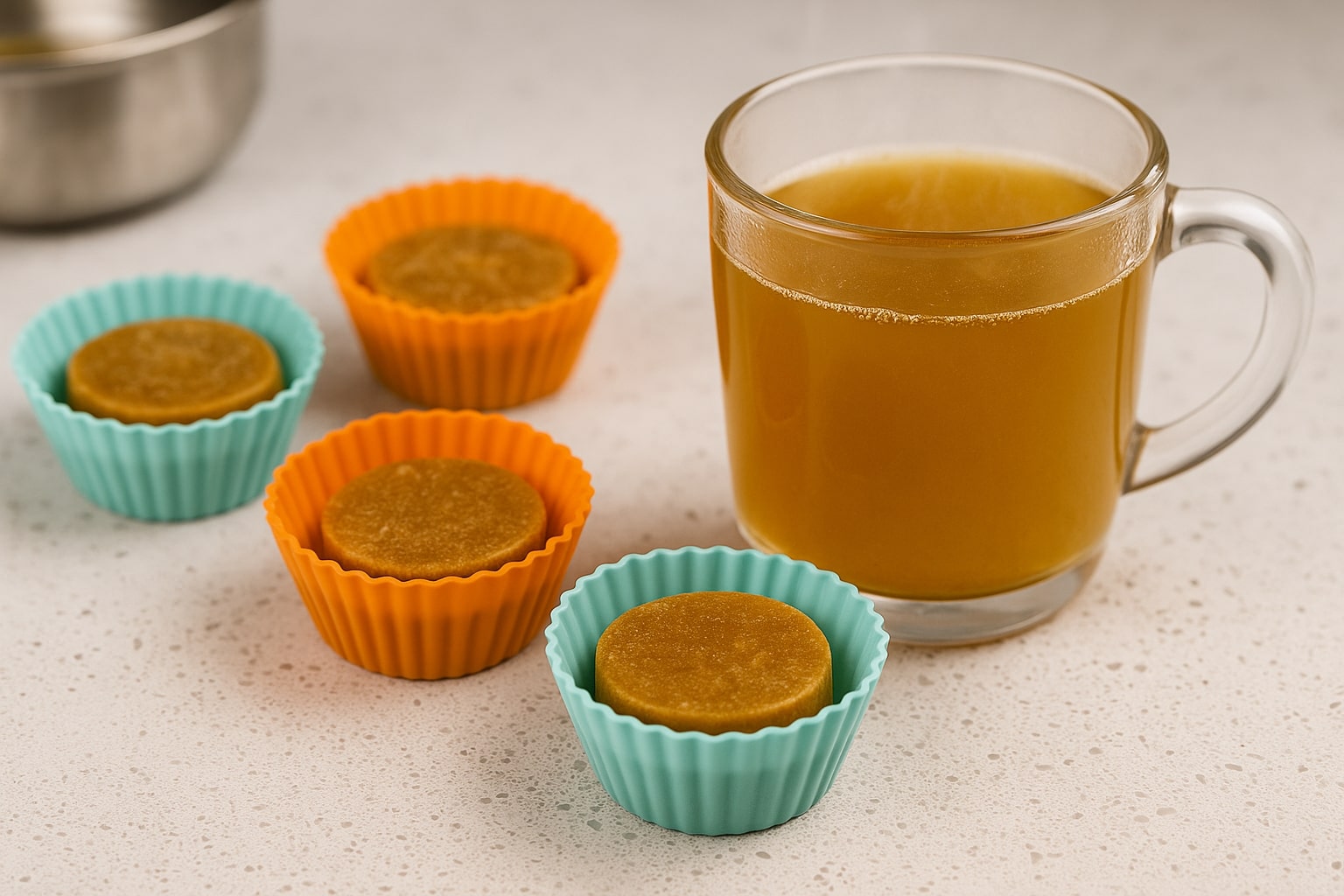
These little broth bombs are my go-to when I need something warm, filling, and fast.
They’re packed with collagen, minerals, and flavor — and they’re perfect for sipping anytime you want a break from heavy meals.
And if you like light, protein-rich snacks, you might also enjoy this fishcakes and scallops stir-fry recipe — it’s another great way to stay Roam-approved between meals.
Ingredients:
-
2 cups pasture-raised bone broth (beef or chicken)
-
½ tsp sea salt (adjust to taste)
-
A pinch of turmeric or black pepper
-
Optional: garlic powder, chili flakes, or lemon juice
-
Silicone muffin tray or ice cube mold
Method:
-
Heat the bone broth in a small saucepan.
-
Add your seasonings and stir until fully blended.
-
Pour the hot broth into silicone molds.
-
Let them cool, then freeze until solid.
-
When ready to use, pop one or two into a mug, add hot water, stir, and sip.
Pro Tip:
I freeze these in silicone cups so I always have a quick snack ready. One cube + hot water = instant nutrition boost.
My Weekly Roam Meal Prep Plan (Beginner Friendly)
When I started following roam diet recipes, I knew meal prep would be key.
But I didn’t want it to take over my weekends or my fridge.
This plan is what actually works for me — it’s quick, realistic, and perfect if you’re just getting into clean eating.
Let me break it down the way I actually do it each week.
Meal Prepping Tips I Swear By
Here’s how I keep my prep short, simple, and stress-free.
-
I cook all my meats in two steps:
-
Use a skillet to sear lamb or beef
-
Toss tougher cuts into the Instant Pot with bone broth and herbs
-
-
I always prep enough protein for 4–5 days
-
I avoid complex recipes during the week — just build meals around the pre-cooked meat
For variety, I prep a few easy sides:
-
Roasted root vegetables
-
Soft-boiled eggs
-
Steamed spinach or garlic greens
Tip: I always include a batch of party-style meat bites — they make great mini meals or snacks when I’m busy.
Storage, Freezing, and Portioning Tips
Here’s what I use to make everything last and stay fresh:
-
Glass meal prep containers — they don’t mess with flavor like plastic does
-
Portion proteins by weight if you’re tracking macros (I don’t, but it helps some folks)
-
Freeze cooked meats in small batches — that way you only thaw what you need
-
Use silicone molds to freeze things like bone broth, gravy, or liver cubes
Pro move: Freeze cooked lamb chops in pairs — quick reheat, no flavor lost.
Sample 3-Day Roam Plan Table
Here’s a simple breakdown of how I eat for 3 days using my meal prep:
| Meal | Day 1 | Day 2 | Day 3 |
|---|---|---|---|
| Breakfast | Liver & Egg Hash | Boiled eggs + roasted carrots | Beef & sweet potato skillet |
| Lunch | Beef lettuce wraps | Leftover lamb with greens | Chicken with mashed root veg |
| Dinner | Garlic herb lamb chops | Bone broth & meat bites | Ground beef bowl + herbs |
My Favorite Time-Saving Hacks
These small changes save me hours each week:
-
Keep pre-chopped garlic and herbs in the fridge
-
Double-cook meats so you can repurpose them into different meals
-
Always keep boiled eggs and frozen broth cubes ready
-
Set a 45-minute timer on Sundays — no overthinking, just prep and go
Bonus: I prep everything with music on. It turns a boring chore into a quick, calm ritual.
Common Mistakes People Make on the Roam Diet

The best part about roam diet recipes is how simple and natural they are — real food, real flavor, no drama.
But even then, it’s easy to go off-track without meaning to.
I’ve made plenty of mistakes myself — especially back when I was experimenting with different ideas like making my own stuffed meat bombs.
They turned out delicious, but I learned the hard way that one wrong sauce or poor-quality cut can throw the whole thing off.
Here’s what to watch out for, especially if you want to stay consistent with clean eating.
Buying the Wrong Type of Meat
Not all meat is Roam-approved — and this is where most people slip up.
Here’s what not to do:
-
Buying “grass-fed” without checking if it’s also grass-finished
-
Picking up cheap, factory-farmed meat just because it’s on sale
-
Assuming labels like “natural” or “organic” = clean (they don’t always)
I recommend building a go-to list of trusted sources or asking your butcher about feed type. It makes a big difference in how you feel after eating.
Not Balancing Fat & Protein
Yes, protein is the star — but don’t ignore good fats.
Common balance mistakes:
-
Eating only lean meats without added fat
-
Skipping things like ghee, bone marrow, or egg yolks
-
Not varying your meat cuts (liver, shank, ground, chops)
My energy levels dropped until I added more fat from lamb fat and ghee — now I feel full and steady all day.
Using Processed Sauces or Additives
This one’s sneaky.
You make a perfect clean meal… then drown it in a bottled sauce full of seed oils and sugar.
What to avoid:
-
BBQ sauces, salad dressings, or spice blends with hidden junk
-
Store-bought stocks with MSG or preservatives
-
Anything labeled “low fat” — usually means high sugar
Always read the ingredients — if it has more than 5 things and you can’t pronounce half of them, it’s probably not Roam-safe.
FAQs About Roam Diet Recipes
Got questions? You’re not alone.
I asked the same things when I started with roam diet recipes, and over time, I figured out what actually matters.
Here’s what most people want to know:
Can vegetarians follow Roam?
Short answer: not really.
The Roam diet is built around animal-based, high-quality proteins, especially grass-fed meat and pasture-raised fats. That said, if you’re a vegetarian exploring clean eating, you might borrow some principles — like avoiding processed foods and focusing on nutrient density.
But for full Roam benefits, meat is essential.
Is dairy allowed in Roam?
It depends — but only in its cleanest form.
If you tolerate dairy well, you can include grass-fed ghee, butter, or even raw milk cheeses.
Avoid ultra-processed dairy, flavored yogurts, or anything with additives.
Pro tip: I stick to ghee. It adds richness without the bloat.
Is this diet good for fat loss?
Absolutely — roam diet recipes are naturally high in protein and healthy fats, which help keep you full longer. That means fewer cravings and less snacking.
Plus, cutting out processed carbs and junk improves your metabolism over time.
For science-backed info, check out this detailed Harvard guide on protein and healthy weight management. It breaks down exactly how protein supports fat loss and energy balance.
Do I need to buy all organic?
No — but quality still matters.
You don’t need to go fully organic. Just focus on pasture-raised and grass-fed sources. Even if they’re not “certified organic,” they’re usually cleaner than mass-market options.
I personally buy local over organic when possible — it’s fresher, cheaper, and just as clean.
Final Thoughts: Time to Roam the Clean Eating Way
Clean eating doesn’t have to be complicated.
With the right ingredients, a few basic tools, and a bit of prep, you can turn everyday meals into something that fuels your body and actually tastes amazing.
These roam diet recipes aren’t about perfection — they’re about progress. Real food, cooked simply, with flavor that speaks for itself.
I recommend picking just one dinner from this post and cooking it tonight.
That’s how I started — one clean meal at a time.
Trust me, once you taste the difference, you won’t want to go back.
